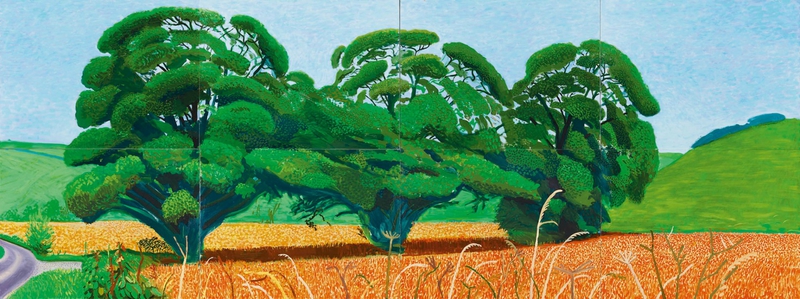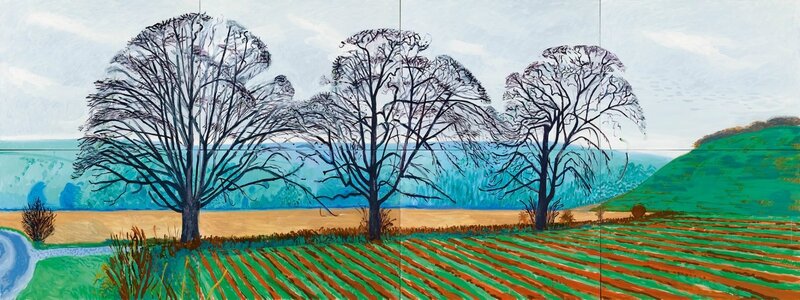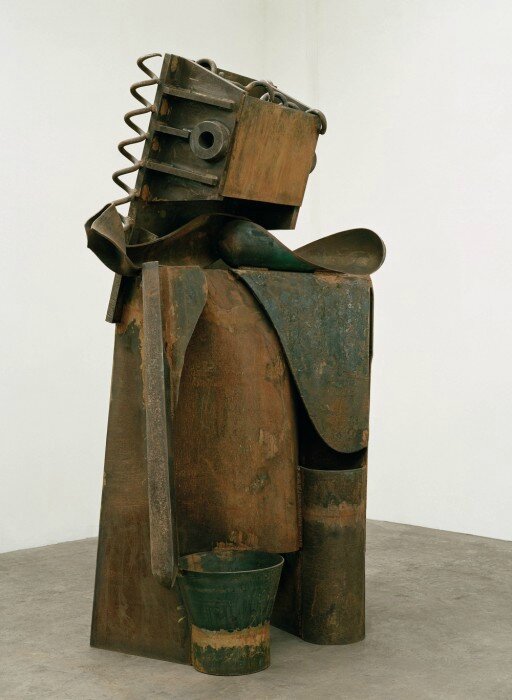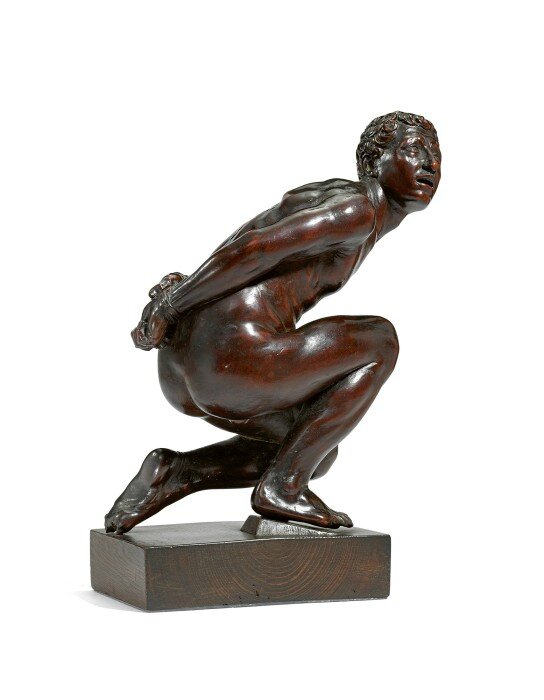Germany's 'screws king' presents art treasure trove in Berlin's Martin Gropius Bau
Hans Holbein the Younger, The Madonna With the Family of Mayor Meyer, („Schutzmantelmadonna“), 1525/26 und 1528, Öl auf Nadelholz, 146,5 x 102 cm. Sammlung Würth, Inv. 14910 © Sammlung Würth, Foto: Philipp Schönborn
BERLIN - The Würth Collection is one of the largest private collections in Europe, containing more than 16,800 works of art. The most important of the classic modern artists are represented, as well as masterpieces from the Middle Ages and classic works of contemporary art. The unusual exhibition is a gain for the Kunstherbst Berlin. With more than 400 works of art of international significance, the collection will be presented to the public in a scope never previously seen, in an exhibition space of 5,000 square meters.
From 11 September 2015, the Martin-Gropius-Bau will present the exhibition “From Hockney to Holbein. The Würth Collection in Berlin”.
David Hockney: Three Trees near Thixendale, Spring, 2008. Sammlung Würth, Inv. 12500 © David Hockney 2015, Foto: Richard Schmidt
Analogously to the history of the Würth Collection, the exhibition delves from the present back into the history of art. Surprises are to be expected. Among the works on display are David Hockney’s season cycle, an international collection of sculptures by artists from Eduardo Chillida to Henry Moore, masterpieces of classical modernism from artists such as Pablo Picasso and Edvard Munch, breathtaking works of decorative art, and a selection of the Würth Collection’s Old Masters, including one of the most significant paintings of the 16th century, Hans Holbein the Younger’s “The Madonna With the Family of Mayor Meyer”. Another highlight is the 25-piece monumental installation “The Last Judgement Sculpture” of British sculptor Anthony Caro in the spectacular atrium of the Martin-Gropius-Bau.
David Hockney: Three Trees near Thixendale, Spring, 2007. Sammlung Würth, Inv. 12501 © David Hockney 2015, Foto: Richard Schmidt
The exhibition represents the latest contribution to the Berlin art scene by the collector Reinhold Würth, who celebrated his 80th birthday this year. He first launched work in 2006, with the establishing of a Chamber of Art in the newly reopened Bode-Museum.
Reinhold Würth’s passion for collecting art was triggered by the work of Emil Nolde. However, another of his purchases was a work by the Danish Constructivist Robert Jacobsen. This proved Würth’s gateway to the postwar Parisian Modernists gathered around the legendary Galerie Denise René, the world of Jean Arp, Sonja Delaunay-Terk, Serge Poliakoff, Aurélie Nemours, Fernand Léger, Günter Fruhtrunk, Jean Dewasne, Auguste Herbin, Victor Vasarely, Jesús Rafael Soto and others. His interest was also piqued by contemporary sculpture, which became another key element of his new but rapidly growing collection. Entire ensembles were assembled of the works of Denmark’s Robert Jacobsen, the Basque Eduardo Chillida, Austria’s Alfred Hrdlicka, the Swiss Max Bill, Britain’s Anthony Caro, and Bulgarian-American Christo and his wife Jeanne-Claude, who in 1995 covered both the Reichstag in Berlin and the Museum Würth in Künzelsau.
David Hockney: Three Trees near Thixendale, Spring, 2008. Sammlung Würth, Inv. 12502 © David Hockney 2015, Foto: Richard Schmidt
However, the Museum Würth also acquired important specimens of modern sculpture by Barbara Hepworth, Henry Moore, Magdalena Abakanowicz, Richard Deacon, Barry Flanagan, Antony Gormley, Eduardo Paolozzi, Erwin Wurm, Jaume Plensa, and Tony Cragg. The collection does not follow a narrow, canonical concept, but maintains an openness that is reflected in its diversity. Reinhold Würth’s talent lies in finding works – often directly from the artists – and in establishing connections; thus his interest also in complexes of works brought together by others.
David Hockney: Three Trees near Thixendale, Spring, 2007. Sammlung Würth, Inv. 12503 © David Hockney 2015, Foto: Richard Schmidt
Reinhold Würth is a collector of collections, as he spectacularly added more items to the collection. The transformed groups of works are presented to the public in Berlin in excerpt form.
The surrealist Max Ernst is represented by some 50 works. He is one of the central figures of the collection, which has a nearly complete collection of his prints and artist’s book with original collages, as well as a magnificent series of paintings and sculptures. It contains Max Ernst incunabula such as the painted doors from the house of Paul Eluard in Eaubonne from 1923, or the original plaster figure of his Young Man with Beating Heart from 1944, towards the end of the Second World War. Thanks to Würth’s broad collecting interests, the magical paintings of Mexican modernism, from Rufino Tamayo to Francisco Toledo, are also to be found in the collection.
Christo: Wrapped Magazines (for Reinhold Würth), 2000. Sammlung Würth, Inv.7510 © Christo 2015, Foto: André Grossman
Important movements of classical modernism, in particular German late Impressionism and Expressionism, are a further focal point of the collection, with Max Beckmann, Ernst Ludwig Kirchner, Max Liebermann and Edvard Munch among the most significant artists represented. Superb groups of works by Georg Baselitz and Anselm Kiefer illustrate the process-orientated nature of history and memory. The erotically charged late work of Pablo Picasso is juxtaposed in a separate room with David Hockney’s striking cycle of the four seasons, representing the poetry of plein air painting.
Carl Spitzweg: Die Nachhilfestunde, 1845. Sammlung Würth, Inv. 3829 © Sammlung Würth
The Old Masters form yet another collection within the collection. A significant impetus was provided by the acquisition of the collection of late mediaeval Old Masters from the castle of Donaueschingen. Supplemented by further important works, such as their three-dimensional counterparts by Tilman Riemenschneider, Daniel Mauch, and others, they form a bridge to the modern age.
A manifest expression of the passionate love of Reinhold Würth for collecting is shown by the collection of precious objets d'art from the "cabinets of curiosities" of the 17th and 18th centuries. The Arch-Cupbearer’s Cup of the Count of Limpurg from 1562 is one of the greatest goldsmith's works of the German High Renaissance. It is listed as a work of national cultural significance, with particular significance to southern Germany.
Pablo Picasso: Venus und Amor, 1968. Sammlung Würth, Inv. 3006 © Succession Picasso / VG Bild-Kunst, Bonn 2015
The following artists are presented in the exhibition:
Magdalena Abakanowicz, Max Ackermann, Horst Antes, Siegfried Anzinger, Karel Appel, Hans (Jean)Arp, Paulus Ättinger, Stephan Balkenhol, Hans Baschang, Georg Baselitz, Jean-Michel Basquiat, Philipp Bauknecht, Willi Baumeister, Max Beckmann, Barthel Beham, Johann Jakob Betzold, Max Bill, Nicolas Bille, Johann Philipp Bonhöffer, Fernando Botero, Herbert Brandl,Daniel Buren, Barthèlemy Caballe, Alexander Calder, Anthony Caro, Sandro Chia, Eduardo Chillida, Giorgio de Chirico, Christo, Johannes Clauss, Francesco Clemente, Tony Cragg, Lucas Cranach d. Ä., Lucas Cranach d. J., Salvador Dalí, Gunter Damisch, Hans Daucher, Richard Deacon, Sonia Delaunay-Terk, Jean Dewasne, Oliver Dorfer, Adam Bernhard Eckard, Paul Ecklott, Paul Egell, Johann Eissler, Paul Eluard, Hans Magnus Enzensberger, Max Ernst, Rainer Fetting, Barry Flanagan, Adolf Fleischmann, Lucio Fontana, Jean-Baptiste Fouache, Günther Fruhtrunk, Katsura Funakoshi, Günter Grass, Hap Grieshaber, Antony Gormley, Hans Hartung, Rudolf Hausner, Xenia Hausner, Barbara Hepworth, Auguste Herbin, André Heurtaux, David Hockney, Karl Horst Hödicke, Rudolf Hoflehner, Hans Holbein d. J., Alfred Hrdlicka, Friedensreich Hundertwasser, Jörg Immendorff, Robert Jacobsen, Anish Kapoor, Alex Katz, Johann Georg Kern, Leonhard Kern, Stephan Kern, Anselm Kiefer, Ernst Ludwig Kirchner, Herbert Kitzel, Yves Klein, Kurt Kocherscheidt, Leon Kossoff, Dieter Krieg, Hans Süss von Kulmbach, Frantisek Kupka, Fernand Léger, Thomas Lenk, Roy Lichtenstein, Max Liebermann, Esaias zur Linden, Egidius Lobenigk, Markus Lüpertz, Alberto Magnelli, René Magritte, Jacek Malczewski, Heinrich Mannlich, Piero Manzoni, André Masson, Joan Miró, Henry Moore, François Morellet, Edvard Munch, Ernst Wilhelm Nay, Aurélie Nemours, Emil Nolde, Tony Oursler, Eduardo Paolozzi, A. R. Penck, Benjamin Péret, Pablo Picasso, Jaume Plensa, Serge Poliakoff, Peter Pongratz, Marc Quinn, Arnulf Rainer, Gerhard Richter, Tilman Riemenschneider, Adolfo Riestra, Christoph (II.) Ritter, Dieter Roth, Christian Schad, Hermann Scherer, Oskar Schlemmer, Claude Émile Schuffenecker, Emil Schumacher, Jesús Rafael Soto, Carl Spitzweg, Henryk Stazewski, Matthias Steinl, Walter Stöhrer, Bernhard Straus , Bernhard Strigel, Rufino Tamayo, Jean Tinguely, Francisco Toledo, Lun Tuchnowski, Günther Uecker, Tomi Ungerer, Victor Vasarely, Andy Warhol, Lambert Maria Wintersberger, Walter Wörn, Paul Wunderlich, Erwin Wurm.
Anthony Caro: Goddess, 2009. Steel, 247 x 138 x 105 cm. Würth collection, Inv. 14130 © Barford Sculptures Limited
The team of curators responsible for the exhibition comprises the curators of the Würth Collection under the direction of C. Sylvia Weber as well as the members of the Art Council of the Würth Group, with Christoph Becker, Thomas W. Gaehtgens, Fabrice Hergott, Martin Roth and Peter-Klaus Schuster. A comprehensive educational program will make the collection accessible to a broad range of visitors.
Lukas Cranach d.Ä.: Die Heilige Barbara, um 1530. Sammlung Würth, Inv. 9325 © Sammlung Würth, Fotograf Archiv Museum Würth
Tilman Riemenschneider: Lüsterweibchen (Chandelier Figure), um 1505-10. Sammlung Würth, Inv. 5926 © Sammlung Würth, Foto: Philipp Schönborn
Max Beckmann: Landschaft bei Saint-Cyr-Sur-Mer, 1931. Sammlung Würth, Inv. 6787 © Sammlung Würth, Foto: Philipp Schönborn
Max Ernst: Ohne Titel (Papillon), 1923. Sammlung Würth, Inv. 10895 © Sammlung Würth
Leonhard Kern: Gefesselter Sklave, 1645. Sammlung Würth, Inv. 14905 © Sammlung Würth, Foto: Volker Naumann
Johann Philipp Bonhöffer und Christoph Ritter: Erbschenkenpokal, 1561-62. Sammlung Würth © Sammlung Würth, Foto: Philipp Schönborn
German billionaire industrialist and art collector Reinhold Wuerth addresses journalists during a press preview of the exhibition "From Hockney to Holbein, The Würth Collection in Berlin" at the Martin Gropius Bau Art Museum in Berlin on September 10, 2015. More than 400 works belonging the Wuerth's art collection are presented to the public from September 11, 2015 to January 10, 2016. AFP PHOTO / ODD ANDERSEN
German billionaire industrialist and art collector Reinhold Wuerth poses in front of the "Schutzmantelmadonna" (Virgin of Mercy), painted by Hans Holbein around 1526, on a press preview of the exhibition "From Hockney to Holbein, The Würth Collection in Berlin" at the Martin Gropius Bau Art Museum in Berlin on September 10, 2015. More than 400 works belonging the Wuerth's art collection are presented to the public from September 11, 2015 to January 10, 2016. AFP PHOTO / ODD ANDERSEN.

/https%3A%2F%2Fprofilepics.canalblog.com%2Fprofilepics%2F1%2F0%2F100183.jpg)
/https%3A%2F%2Fstorage.canalblog.com%2F03%2F02%2F119589%2F96711876_o.jpg)
/https%3A%2F%2Fstorage.canalblog.com%2F11%2F31%2F119589%2F94773502_o.jpg)
/https%3A%2F%2Fstorage.canalblog.com%2F20%2F83%2F119589%2F94772815_o.jpg)
/https%3A%2F%2Fstorage.canalblog.com%2F26%2F72%2F119589%2F75604929_o.jpg)
/https%3A%2F%2Fstorage.canalblog.com%2F59%2F60%2F119589%2F26458628_o.jpg)



















/http%3A%2F%2Fstorage.canalblog.com%2F24%2F91%2F119589%2F129085359_o.jpg)
/http%3A%2F%2Fstorage.canalblog.com%2F33%2F01%2F119589%2F127774658_o.jpg)
/http%3A%2F%2Fstorage.canalblog.com%2F59%2F72%2F119589%2F127649775_o.jpg)
/http%3A%2F%2Fstorage.canalblog.com%2F55%2F19%2F119589%2F127209400_o.jpg)